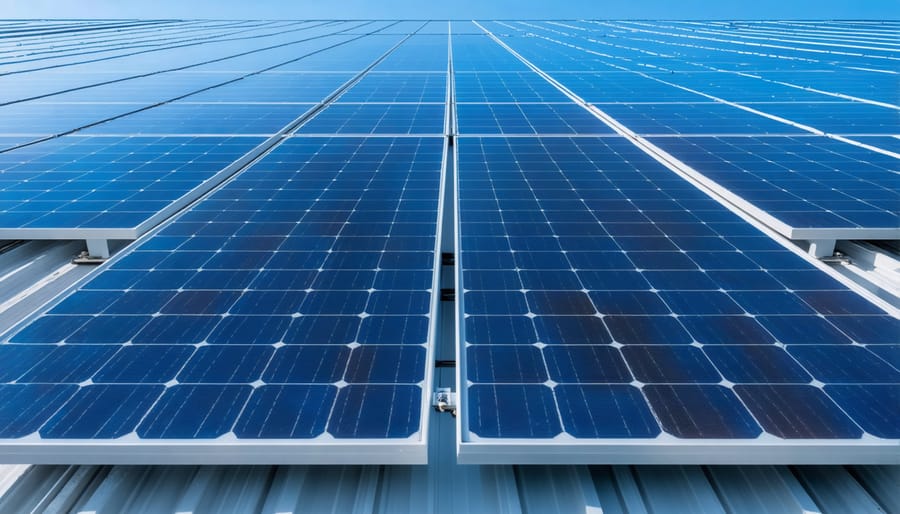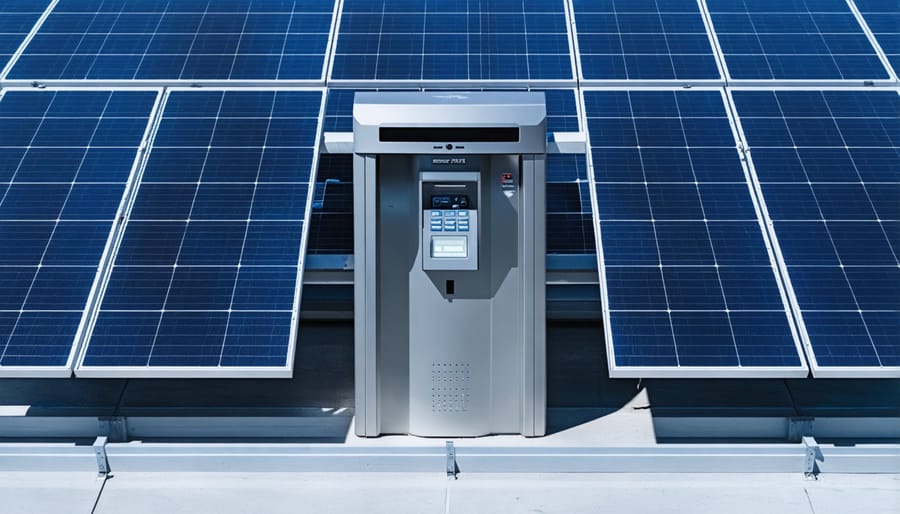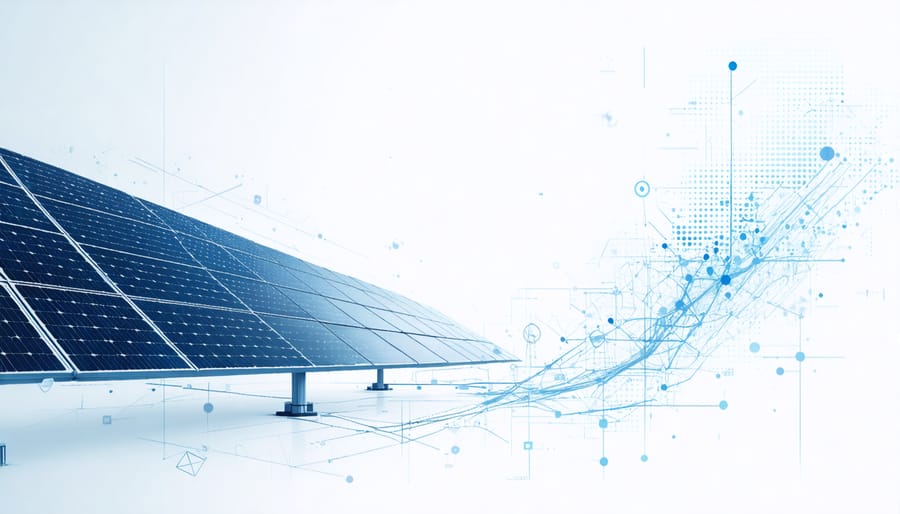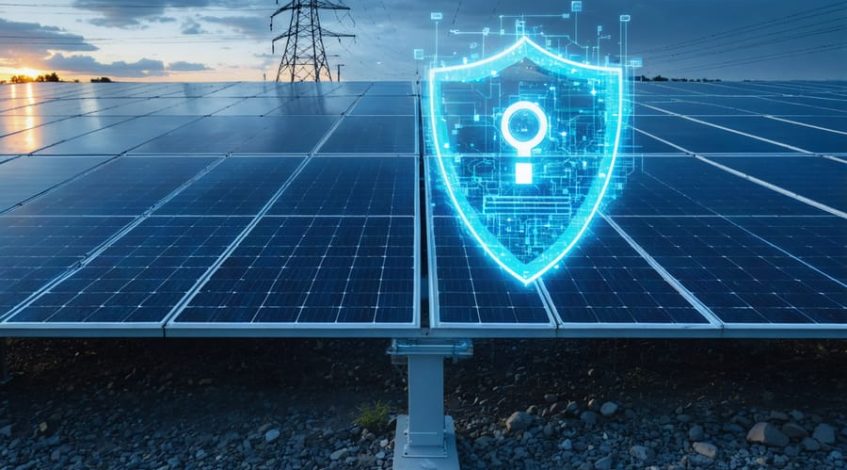Assess your solar infrastructure’s cybersecurity posture using the FCC’s Small Biz Cyber Planner 2.0, a framework specifically designed to help organizations without dedicated security teams identify vulnerabilities in internet-connected energy systems. This planning guide provides a structured approach to protecting distributed energy resources from increasingly sophisticated cyber threats that can compromise operational technology, disrupt energy production, and expose sensitive business data.
Commercial solar installations face unique cybersecurity challenges that traditional IT security frameworks often overlook. Inverters, monitoring systems, and grid-tied equipment create multiple attack vectors where malicious actors can infiltrate networks. The FCC cybersecurity planning guide addresses these vulnerabilities through a practical, six-step methodology that aligns risk assessment with business continuity requirements—essential for maintaining the financial performance and regulatory compliance that drive solar investment ROI.
Recent data reveals that 43% of cyberattacks target small to medium-sized businesses, with critical infrastructure sectors experiencing disproportionately higher threat levels. Solar facilities operating with inadequate cybersecurity protocols risk production losses averaging $84,000 per incident, alongside potential liability exposure and damaged stakeholder confidence. These financial implications make cybersecurity planning not merely a technical necessity but a business imperative.
The FCC framework offers decision-makers a cost-effective alternative to expensive consultant engagements while maintaining technical rigor. By following its structured assessment process, facility managers can identify critical assets, evaluate existing controls, prioritize remediation efforts, and establish ongoing monitoring protocols—all without requiring specialized cybersecurity expertise. This democratization of security planning proves particularly valuable for organizations scaling their renewable energy portfolios across multiple sites.
Understanding and implementing the FCC cybersecurity planning guide transforms solar infrastructure from a potential vulnerability into a resilient, protected asset that delivers sustained value.
The Growing Cyber Threat Landscape for Solar Energy Systems

How Modern Solar Systems Connect to Networks
Today’s commercial solar installations operate as sophisticated digital networks, far beyond simple panels collecting sunlight. Understanding these interconnected components is essential for implementing effective cybersecurity measures that protect your energy infrastructure investment.
At the heart of modern solar systems are smart inverters, which convert DC power from panels into usable AC electricity while simultaneously communicating performance data across networks. These devices connect to solar monitoring systems that track energy production, system health, and operational efficiency in real-time.
Internet of Things (IoT) sensors throughout the installation measure environmental conditions, panel temperatures, and equipment status. These sensors transmit continuous data streams to centralized management platforms, enabling predictive maintenance and performance optimization.
For larger commercial installations, Supervisory Control and Data Acquisition (SCADA) systems provide comprehensive oversight and control capabilities. SCADA platforms manage multiple solar arrays, coordinate with building management systems, and facilitate grid integration—all while maintaining constant network connectivity.
Cloud-based management platforms tie these components together, offering facility managers remote access to performance analytics, automated reporting, and system controls from any location. These platforms often integrate with enterprise resource planning systems and energy trading platforms.
This digital ecosystem delivers substantial operational benefits: reduced maintenance costs, maximized energy production, and data-driven decision-making. However, each network connection represents a potential entry point for cyber threats. A 2023 analysis of energy sector incidents revealed that 67% of compromised solar installations were accessed through inadequately secured monitoring systems. Protecting these digital touchpoints requires comprehensive cybersecurity planning aligned with established frameworks.
Real-World Consequences of Solar Infrastructure Breaches
The energy sector has experienced significant cyber incidents that demonstrate the critical importance of robust security measures. In December 2015, Ukraine’s power grid suffered a coordinated cyberattack that left 230,000 residents without electricity for several hours. Attackers exploited cybersecurity vulnerabilities in industrial control systems, highlighting how energy infrastructure remains a prime target.
More recently, a 2021 ransomware attack on a U.S. solar panel manufacturer resulted in production halts and estimated losses exceeding $2 million. The incident disrupted supply chains and delayed installations for multiple commercial clients, demonstrating how operational disruptions cascade throughout the industry.
Solar facilities face similar risks through compromised inverters, energy management systems, and monitoring platforms. A breach can enable unauthorized access to grid-connected systems, manipulate energy output data, or disable critical safety mechanisms. Financial implications extend beyond immediate recovery costs to include regulatory fines, legal liabilities, and increased insurance premiums.
Reputational damage proves equally costly for facility operators and manufacturers. Commercial clients and government entities increasingly demand verifiable cybersecurity standards before partnership agreements. A single security incident can erode stakeholder confidence, resulting in contract cancellations and diminished market competitiveness. For solar infrastructure providers, implementing comprehensive cybersecurity planning frameworks isn’t merely regulatory compliance—it’s essential business continuity protection that safeguards investments and maintains operational integrity in an increasingly connected energy landscape.
Understanding the FCC Cybersecurity Planning Guide Framework
Five Core Components of the FCC Framework
The FCC’s cybersecurity planning guide establishes five interconnected components that form a comprehensive defense strategy for critical infrastructure, including commercial solar installations. Understanding these pillars enables organizations to build robust protection for their energy assets while maintaining operational efficiency.
**Governance** serves as the foundation, establishing clear cybersecurity policies, assigning responsibilities across your organization, and ensuring leadership commitment to security initiatives. For solar facilities, this means defining who oversees system monitoring, access controls, and compliance verification. Effective governance translates directly to reduced vulnerability exposure and improved incident response times.
**Risk Management** requires systematic identification and assessment of potential threats to your solar infrastructure. This component guides organizations through evaluating vulnerabilities in inverter communications, SCADA systems, and remote monitoring platforms. By prioritizing risks based on likelihood and impact, facility managers can allocate resources efficiently, focusing protection efforts where they deliver maximum ROI.
**Asset and Configuration Management** mandates maintaining accurate inventories of all hardware, software, and network components within your solar installation. This includes cataloging inverters, monitoring equipment, control systems, and communication devices. Proper configuration management ensures systems operate with secure settings and unauthorized changes are detected promptly.
**Threat and Vulnerability Management** establishes protocols for continuous monitoring, applying security patches, and addressing newly discovered weaknesses. Solar facilities must regularly assess their operational technology networks for emerging threats, particularly given the increasing sophistication of attacks targeting energy infrastructure.
**Incident Response Planning** prepares organizations to detect, contain, and recover from security breaches efficiently. A well-documented response plan minimizes downtime costs and protects your facility’s energy production capacity. Real-world applications demonstrate that organizations with tested incident response procedures recover 60% faster from cybersecurity events, directly protecting revenue streams and maintaining customer confidence.
Why This Framework Works for Solar Installations
The FCC Cybersecurity Planning Guide translates seamlessly to solar installations because both telecommunications and energy infrastructure share common vulnerabilities: remote monitoring systems, networked devices, and critical operational data. The framework’s risk-based approach allows facility managers to prioritize threats specific to their solar arrays—from inverter tampering to SCADA system breaches—while scaling protection measures according to installation size and complexity.
Commercial solar operations benefit particularly from the Guide’s emphasis on vendor risk management and supply chain security, addressing concerns about compromised hardware before deployment. The framework’s structured assessment methodology enables organizations to identify vulnerabilities in their existing infrastructure systematically, then implement graduated controls that align with budgetary constraints. Real-world applications demonstrate measurable ROI: facilities implementing FCC-aligned protocols report reduced downtime, lower insurance premiums, and enhanced investor confidence. This practical alignment ensures that cybersecurity investments directly protect revenue-generating assets while maintaining operational efficiency across distributed solar networks.
Implementing FCC-Aligned Cybersecurity Protocols for Your Solar Infrastructure
Asset Inventory and Network Segmentation
Establishing a comprehensive asset inventory forms the foundation of effective cybersecurity planning for your solar infrastructure. Begin by cataloging every digital component in your system—inverters, monitoring devices, controllers, communication gateways, and energy management software. Document each asset’s make, model, firmware version, network location, and function within your operation. This detailed inventory enables you to identify vulnerabilities and prioritize security investments based on criticality.
Network mapping reveals how these components communicate and where potential security gaps exist. Chart all communication pathways between devices, data flows to cloud platforms, and connections to external networks. Understanding these relationships helps identify which systems require heightened protection and where unauthorized access could compromise operations.
Implementing network segmentation isolates critical infrastructure from less secure systems, significantly reducing your attack surface. Create separate network zones for operational technology controlling energy production, business systems handling administrative functions, and guest networks for visitor access. This containment strategy ensures that if one zone experiences a security breach, attackers cannot easily pivot to mission-critical systems.
A commercial solar facility in California demonstrated this approach’s effectiveness after implementing three-tier network segmentation. When a routine maintenance laptop introduced malware through a guest network, the infection remained contained, preventing any disruption to energy production systems. The facility maintained operational continuity while addressing the threat—exemplifying how proper segmentation transforms potential crises into manageable incidents. Regular inventory updates and network reviews ensure your security architecture evolves alongside your expanding solar infrastructure.

Access Control and Authentication Measures
Implementing robust access control measures represents a fundamental pillar of smart cybersecurity strategies for commercial solar installations. Organizations must establish clear protocols governing who can access monitoring and control systems, ensuring that only authorized personnel interact with critical infrastructure.
Multi-factor authentication (MFA) should be mandatory for all system access points, requiring users to verify their identity through multiple credentials beyond passwords. This approach significantly reduces the risk of unauthorized access, even when credentials are compromised. Industry data shows that MFA can prevent up to 99.9% of automated attacks.
Role-based access control (RBAC) ensures employees and contractors receive only the permissions necessary for their specific functions. For example, maintenance technicians might access operational data without modification privileges, while system administrators maintain broader control. This principle of least privilege minimizes potential damage from both internal threats and compromised accounts.
Vendor management requires particular attention, as third-party service providers often need system access for monitoring and maintenance. Establish formal agreements defining access parameters, duration limits, and audit requirements. A Queensland manufacturing facility reduced security incidents by 60% after implementing time-limited vendor access protocols with automatic session termination.
Regular access audits should occur quarterly, reviewing user accounts, removing inactive credentials, and updating permissions based on personnel changes. Strong password policies, including complexity requirements and regular rotation schedules, complement these technical controls while remaining practical for daily operations.
Continuous Monitoring and Threat Detection
Establishing comprehensive monitoring protocols is essential for detecting and responding to cyber threats targeting solar infrastructure. Real-time surveillance systems should continuously track network traffic, system performance metrics, and user access patterns across all connected devices, from inverters to energy management platforms.
Begin by documenting baseline behaviors for your solar systems during normal operations. Record typical data transmission volumes, communication frequencies between components, and standard performance parameters. These baselines serve as reference points for identifying deviations that may indicate security incidents or system compromises.
Deploy continuous monitoring tools that utilize machine learning algorithms to detect anomalies in real-time. Configure automated alert systems to notify security teams immediately when suspicious activities occur, such as unauthorized access attempts, unusual data transfers, or unexpected configuration changes.
Implement a tiered alert structure that prioritizes threats based on severity and potential impact. Critical alerts—such as ransomware indicators or control system intrusions—should trigger immediate response protocols, while lower-priority notifications can be addressed through routine security reviews.
Case studies demonstrate that organizations with proactive monitoring reduce incident response times by 60% and minimize financial losses from cyberattacks. One Australian commercial facility prevented a significant breach by detecting abnormal communication patterns from their inverter network, enabling rapid isolation before damage occurred.
Integrate monitoring data with your security information and event management (SIEM) system to correlate events across multiple sources and identify sophisticated attack patterns that individual tools might miss.
Building a Solar-Specific Incident Response Plan
Assembling Your Response Team and Defining Roles
Effective cybersecurity incident response requires a well-coordinated team with clearly defined responsibilities. Your response team should include your facility manager or operations director as the primary coordinator, who maintains oversight of all solar infrastructure systems. Designate an IT security professional—either internal staff or a contracted specialist—to handle technical threat analysis and system remediation.
Include your solar installation provider or maintenance contractor in the response framework, as they possess specialized knowledge of inverter systems, monitoring platforms, and equipment-specific vulnerabilities. Their technical expertise proves invaluable when assessing whether anomalies stem from cybersecurity threats or equipment malfunctions.
Establish a regulatory liaison responsible for communication with relevant authorities, including utility companies and, if applicable, the Federal Communications Commission regarding network-connected devices. This role ensures compliance with reporting requirements and maintains transparent stakeholder communication.
Document each team member’s contact information, responsibilities, and decision-making authority in your incident response plan. Consider a real-world application from a California commercial facility: their predefined response team contained a cyberattack within four hours by immediately activating their structured protocol, preventing potential system-wide compromise. Regular training exercises ensure team members understand their roles and can execute coordinated responses under pressure, minimizing downtime and protecting your solar investment’s return on investment.

Recovery Procedures That Minimize Downtime
Implementing a structured recovery procedure is essential to minimize operational disruptions following a cyber incident. Begin by isolating affected systems immediately—disconnect compromised solar inverters, monitoring equipment, and network components from both the internet and your internal network to prevent lateral movement of threats. Document all observations and system states before making changes, as this information proves valuable for both forensic analysis and insurance claims.
Next, activate your incident response team and establish communication protocols with key stakeholders, including utility partners, regulatory authorities, and your cybersecurity vendor. According to a 2023 study of commercial solar facilities, organizations with pre-established communication chains reduced recovery time by an average of 47% compared to those without formal procedures.
Execute system restoration from verified clean backups stored offline, starting with the most critical operational systems. Before reconnecting any equipment, apply security patches and updates that address identified vulnerabilities. Implement temporary security measures such as network segmentation and enhanced monitoring to detect any signs of re-infection during the recovery phase.
Conduct thorough validation testing of each restored system in isolation before reintegrating it into your production environment. This includes verifying proper functionality of solar inverters, energy management systems, and SCADA interfaces. A leading manufacturing facility in California successfully restored operations within 36 hours using this phased approach after a ransomware attack, maintaining partial energy production throughout recovery while protecting system integrity.
Finally, perform a comprehensive post-incident review to identify gaps in your security posture and update your cybersecurity planning guide accordingly.
Compliance Considerations and Industry Standards
While the FCC Cybersecurity Planning Guide provides a foundational framework, commercial solar operators must navigate a complex landscape of additional regulations and industry standards. Understanding these requirements is essential for comprehensive risk management and operational continuity.
For facilities connected to critical infrastructure, the North American Electric Reliability Corporation Critical Infrastructure Protection (NERC CIP) standards establish mandatory cybersecurity requirements. These standards apply to solar installations exceeding certain generation thresholds and those directly connected to bulk electric systems. NERC CIP encompasses stringent controls for access management, incident reporting, and recovery planning that extend beyond basic FCC recommendations.
State-level regulations add another compliance layer, with jurisdictions implementing varying data protection and energy infrastructure security requirements. California’s cybersecurity regulations for energy providers, for instance, mandate specific reporting protocols and security assessments. Organizations operating across multiple states must develop scalable frameworks accommodating diverse regulatory environments.
Insurance considerations increasingly influence cybersecurity planning decisions. Insurers now require documented cybersecurity programs and compliance evidence before providing coverage for cyber-related incidents. Facilities demonstrating robust security postures aligned with recognized frameworks like the FCC guide often secure more favorable premium rates and coverage terms, directly impacting operational costs.
The financial implications extend to contractual obligations, as power purchase agreements increasingly incorporate cybersecurity requirements. Utility partners and corporate energy buyers demand assurance that solar installations meet industry-standard security practices, making compliance a competitive differentiator.
Real-world application demonstrates the value of integrated compliance approaches. A recent case study involving a 15MW commercial solar facility showed that comprehensive framework adoption reduced insurance premiums by 23% while satisfying multiple regulatory requirements simultaneously, delivering measurable return on security investments.
The ROI of Cybersecurity Investment in Solar Infrastructure
Investing in cybersecurity for solar infrastructure delivers measurable returns that extend far beyond preventing data breaches. Industry analysis reveals that implementing comprehensive cybersecurity protocols costs approximately 3-5% of total system infrastructure investment, while the average cost of a successful cyberattack on energy systems ranges from $500,000 to $3 million, factoring in downtime, remediation, regulatory penalties, and reputational damage.
Prevention economics strongly favor proactive security measures. A mid-sized commercial solar installation spending $50,000 on robust cybersecurity infrastructure protects against potential losses exceeding ten times that amount. System downtime caused by cyber incidents directly impacts revenue generation—every hour of compromised operations translates to lost energy production and missed performance guarantees with utility partners.
Insurance markets increasingly recognize this reality. Organizations demonstrating mature cybersecurity frameworks based on FCC guidelines often secure 15-25% reductions in cyber liability premiums. Insurers view comprehensive security protocols as risk mitigation tools, rewarding facilities that implement multi-layered defense strategies with more favorable policy terms and lower deductibles.
Beyond financial protection, cybersecurity excellence creates competitive differentiation. Government agencies and Fortune 500 companies now mandate stringent security requirements in their procurement processes. A documented cybersecurity program aligned with recognized standards like the FCC framework positions organizations to compete for high-value contracts where security compliance serves as a qualifying criterion rather than an afterthought.
System reliability improvements represent another tangible benefit. Facilities implementing comprehensive security protocols report 40% fewer unplanned outages and 60% faster recovery times when incidents occur. This enhanced reliability strengthens relationships with power purchasers, supports premium pricing negotiations, and enables facilities to meet increasingly stringent service-level agreements.
Real-world application demonstrates these principles: a California-based solar farm consortium implementing FCC-aligned security measures secured three major municipal contracts specifically citing their cybersecurity posture as a deciding factor, generating $12 million in additional annual revenue against their $200,000 security infrastructure investment—a compelling 60:1 return ratio that validates the business case for comprehensive cybersecurity planning.

The proliferation of connected solar installations has created unprecedented efficiency gains, but also introduced cybersecurity vulnerabilities that demand immediate attention. As commercial solar systems become increasingly sophisticated and integrated with enterprise networks, the potential impact of a cyberattack extends beyond data breaches to operational disruptions, financial losses, and compromised energy reliability. The FCC’s cybersecurity planning framework provides a structured, practical approach that organizations can immediately apply to their solar infrastructure.
Key takeaways from this framework emphasize that effective cybersecurity is not a one-time implementation but an ongoing commitment. Regular vulnerability assessments, comprehensive employee training, robust access controls, and incident response planning form the foundation of a resilient security posture. Organizations must view cybersecurity investments as essential components of their solar infrastructure—comparable in importance to the panels and inverters themselves.
Business leaders should conduct thorough audits of their current cybersecurity measures, identifying gaps and prioritizing remediation efforts based on risk exposure. This proactive approach not only protects critical energy assets but also demonstrates due diligence to stakeholders, regulators, and insurance providers.
Partnering with experienced solar providers who integrate cybersecurity into their installation and maintenance protocols is crucial. These partnerships ensure that security considerations are addressed from initial design through ongoing operations. The return on investment for robust cybersecurity planning far exceeds the potential costs of breaches, downtime, and reputational damage. Take action today to secure your solar infrastructure and protect your organization’s energy future.

